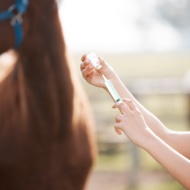Rare rhino born at Chester Zoo
The calf is feeding regularly and gaining weight.
An eastern black rhinoceros calf has been born at Chester Zoo, boosting efforts to conserve the species.
The female calf was delivered on 12 November, with mother Zuri giving birth over a bed of soft sand following a 15-month pregnancy.
Unusually for the species, she gave birth during daylight, allowing keepers to record the moment on camera.
The eastern black rhinoceros is a critically endangered species, according to the International Union for the Conservation of Nature. There are fewer than 600 left in Kenya, Rwanda, and Tanzania.
Although data released earlier this year showed that numbers had increased slightly, poachers looking for rhino horn are still a significant threat to the species.
Chester Zoo is among the institutions working to save the eastern black rhinoceros. The zoo is home to an animal endocrine laboratory, where scientists have been using dung to monitor rhinoceros hormones.
The technology has helped keepers improve the chances of successful mating. It will soon be transferred to a laboratory in Kenya to help local rangers and veterinary surgeons increase the wild population.
Rhino team manager Emma Evison said: “Sadly this is a species that, for more than century, has been hunted down and poached for its horn before being sold on the illegal wildlife markets.
“This precious newborn’s arrival is another positive step in safeguarding the species, which is what the endangered species breeding programme in European conservation zoos that we’re a leading part of is striving to do.
“This programme has already showed huge success, with a group of rhinos bred in zoos in Europe having been translocated to a protected National Park in Africa.”
Image © Chester Zoo



 Zoetis UK has apologised for a supply shortage of Equip Artervac, caused by a manufacturing issue.
Zoetis UK has apologised for a supply shortage of Equip Artervac, caused by a manufacturing issue.